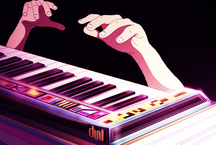13 best digital piano
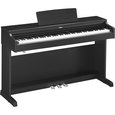
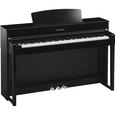



Buying a digital piano is not a big deal, in this market even the simplest models cost a lot of money. Let's try to choose the electric piano that is right for you.
When we recently wrote about choosing the best synthesizer, involuntarily constantly suggested comparisons with real keyboard instruments, and first of all with a piano. And, as it turned out, not every synthesizer can imitate the game on this particular instrument. But what to do if you want to play exactly the piano, but dragging a rather big instrument home that requires regular tuning is not an option? Well, the answer is - buy a digital piano.
What is the principal the difference between a digital piano and a synthesizer? First of all - it is keyboard. It usually contains all 88 keys (there are “truncated” models), and their mechanics are fully weighted, that is, when pressed, the characteristic “weight” is felt (and the bass is “heavier” than the treble), allowing you to sharpen the technique of working your fingers it would be on a “real” instrument. Conventional synthesizers of the lower and middle price range have a maximum semi-weighted mechanics, and you can’t recommend them to a beginner pianist - you can’t get the right technique, especially for weak fingers. High-end digital pianos have a hammer mechanics that completely replicates this instrument - it is almost impossible to distinguish them by touch.
Next, go to pedals. If for a synthesizer the pedal connection is an option, and its purpose differs from the usual for pianists, for a digital piano the use of pedals is an integral part of the playing technique, at least the right one is used to silence the sound when the keys are released or, on the contrary, to preserve the after-sounding and enrichment of the sound overtones.
Well and naturally sound. First of all, it is a rich bank of samples that are recorded from a “live” instrument, and not synthesized by a digital circuit. The sound of such an electronic piano as close as possible to the studio play on a live instrument. The acoustics are “sharpened”, again, to the sound of the piano, while conventional synthesizers use conventional broadband speakers.
By execution, there are three types of tools:
- Portable digital piano not distinguish externally from a full-sized 88-key synthesizer: the pedals are connected to it separately, it itself is installed on the stand when playing.
- Building "modern" - this is a lightweight design, in the upper part of which the keyboard is fixed, on the lower cross member there are pedals. This tool is convenient for low weight, at home it will occupy a minimum of space, while fully imitating the fit of the "real" piano.
- Classic case - This is a closed design, as close as possible to the form of a conventional piano. But it takes the same place, winning only in mass. On the other hand, “warm luminosity” is undoubtedly present - the tool framework itself, resonating, works together with the speaker system.
| Category | A place | Name | Rating | Price |
|---|---|---|---|---|
| The best budget portable digital piano | 1 | CASIO CDP-130 | 9.5 / 10 | 28 990 |
| 2 | Yamaha NP-32 | 9.4 / 10 | 23 990 | |
| 3 | Yamaha NP-12 | 9.0 / 10 | 17 990 | |
| The best high-end portable digital piano | 1 | CASIO PX-5S | 9.8 / 10 | 69 990 |
| 2 | Kurzweil KA110 | 9.6 / 10 | 58 700 | |
| 3 | Roland FP-30 | 9.2 / 10 | 47 990 | |
| 4 | KAWAI ES100 | 9.0 / 10 | 54 900 | |
| The best corps "modern" middle-class piano | 1 | KORG LP-380 | 9.7 / 10 | 65 000 |
| 2 | Yamaha YDP-142 | 9.6 / 10 | 61 871 | |
| 3 | Medeli DP680 | 9.3 / 10 | 63 832 | |
| The best corpus "modern" high-class piano | 1 | Yamaha YDP-163 | 9.9 / 10 | 89 990 |
| 2 | Roland RP501R | 9.5 / 10 | 95 989 | |
| The best corpus digital piano high class | 1 | Yamaha CLP-545 | 10 / 10 | 134 990 |
The best budget portable digital piano
|
28 990
Initially, setting the ceiling of the price of 25 thousand rubles for the budget class “portable”, we immediately had to make a compromise - although “Casio” went out of this framework by almost a thousand, it still remains a regular “state employee” in its essence. First of all, we will give him first place in the ranking of the best low-cost digital pianos for having only one of the world's brands in this price range, a full-size 88-key keyboard: competitors from Yamaha offer only “truncated” for a close price. By itself, the tool is very weighty and passes a little over 10 kilograms, keep this in mind when choosing a stand. The choice of musician 10 different timbres - in particular, a classical piano, electric piano, organ and, suddenly, a violin! Well, we will take it as a “bonus” from the manufacturer. As in Casio synthesizers of the same class, by pressing a single button, you can activate the Hall function, a digital reverb simulating the acoustics of a concert hall. His work is well heard in the widely spaced 8-watt speakers, especially well combined with the sound of the organ. The keyboard ... Of course, it is foolish to approach the budget instrument from the standpoint of a professional pianist. In general, it is very, very pleasant, but it can be blamed on the apparent side play and excessive “slipperiness” of the keys. But you can really feel the negative aspects of these nuances only on fast passages that a beginner pianist simply cannot master. We note another bonus from the manufacturer - the ability to connect the piano to a computer as a MIDI keyboard. Of course, the pads will obviously be missed, but you can’t buy a full-sized keyboard with weighted mechanics and a hammer mechanism (!) For 26 thousand somewhere else. Main advantages:
Minuses:
|
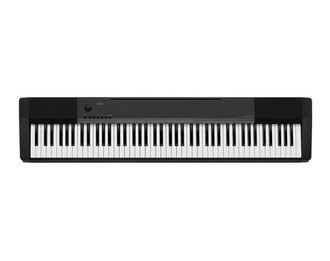 9.5 / 10
Rating
Reviews
The best option for teaching music, with this digital piano, we “spent a lot of time together” - long after the music school, he was more than happy with me. |
|
23 990
Hmm ... After Casio Yamaha, standing a little cheaper, it looks really pale - instead of a full-sized keyboard, there are only 76 keys, and the hammer mechanism is not “delivered” to them. However, not for nothing that this compact digital piano is included in the ranking of the best? No, not in vain. The main trump card "Yamaha" - is the sound. Here, Casio really loses, and noticeably. Even it becomes a pity that the company installed not the best acoustics in the piano - the sound of NP-32 is revealed in a new way in high-quality headphones. The set of effects is traditional, first of all, we note the high-quality reverb and chorus. For a novice musician, the built-in looper will be especially useful - having recorded the play of one instrument in his memory, you can switch the mode and play another virtual instrument on top of the recording. There is also a split keyboard mode that allows you to do the same “live” - one hand plays the part of one instrument, the other - of the other. There is also a MIDI interface, so that the piano can always be used with any VST synthesizer on a computer. Main advantages:
Minuses:
|
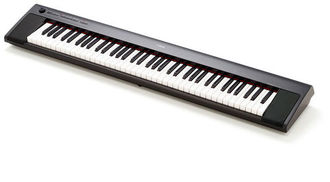 9.4 / 10
Rating
Reviews
Bought a piano to his son for training on the advice of a friend pianist. I'm not a pro, but I really liked the sound. |
|
17 990
Here the keyboard is even smaller - 61 key. But the difference in price with the "32nd" model is more than palpable - is it really only because of this? Let's try to figure it out. To begin with, the keyboard shortening is compensated by the built-in transpose function.Of course, if you play passages through the entire keyboard, it will be inconvenient to use transposing, but do you often need it? The sound here is exactly the same as sampled from real Yamaha instruments, in order to reduce the cost, the built-in acoustics suffered - the power was reduced, the speakers themselves sound coarser in sound. So, they started to play, but something was missing ... That's right - the right pedal is optional, here is another secret of price reduction. Most of all here suffered the keyboard. If in NP-32 the basses were noticeably harder, then here the response from the keys does not depend on an octave, and this greatly spoils the instruments in comparison. Should NP-12 be considered as an alternative? Perhaps only if the issue price is so acute. Main advantages:
Minuses:
|
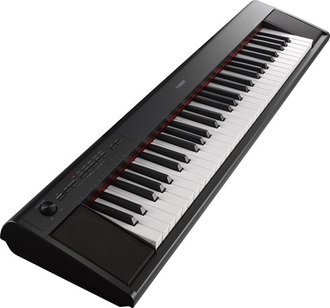 9.0 / 10
Rating
Reviews
Honestly, not the best digital piano for a beginner - I played a lot at home, and in the music center I started to fake on a regular piano, the bass lacks gravity. |
The best high-end portable digital piano
|
69 990
Ummm ... Is it definitely not a synthesizer? After a simple, low-cost digital piano, this question can really come to mind. But no, despite the presence of pitch and modulation twists, this is exactly the piano. And, we note, with a great bank of samples, the wealth of which can only envy. The keyboard is made on a solid top five - moderately rough keys are pleasant under the fingers, demonstrate a refined sensitivity to pressing, and hammer mechanics works completely indistinguishable from the "live" tool. But Casio has much more opportunities - we mention at least the possibility of dividing the keyboard into 4 zones, the built-in memory looper for 100 songs and a bi-directional MIDI interface (that is, the piano can not only “command” VST on a computer, but also play MIDI tracks with him). It is curious that the built-in acoustics is not here, which clearly hints at the concert purpose of the instrument. Well, at the concert you still have to play “in the remote”, and at home you can connect your favorite speaker system. Of the minuses, we point out the monstrous interface - the pianist, rather than the pianist, can understand the settings menu more likely. On the other hand, all the most frequently needed functions are always at hand. Main advantages:
Minuses:
|
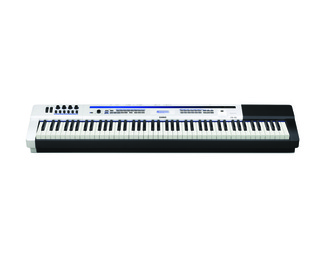 9.8 / 10
Rating
Reviews
Not the first year I have been playing, with this tool I have traveled almost the entire country. Good digital piano, I'm not going to change it. |
|
58 700
It is not quite fair to apply the term “piano” to this instrument: some of the functionality here is closer to the synthesizers, but the KA110 plays the role of the piano perfectly - a comfortable and lively touch keyboard with excellent sensitivity, and sound samples are written here with close to perfect detail. The weight of the tool surprised - almost 20 kilograms! To a large extent, the culprit of this is the built-in acoustics with a total power of 60 watts, which allows you to play in a small room not “in the apparatus”, but on your own. If we add to this the built-in auto accompaniment, then we have a great choice of a pub tavern ... that is, of course, a musician performing in cafes and bars. Given that Kurzweil can also be used to play MIDI from an external source, there is the ability to play and record music on an SD card, we can safely recommend it to a “human orchestra” performing the role of the entire ensemble at a performance. Main advantages:
Minuses:
|
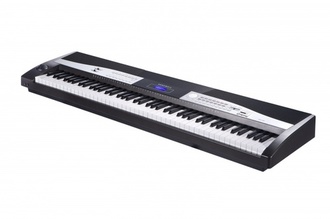 9.6 / 10
Rating
|
|
47 990
The main advantage of the FP-30 is sound: it was hard to expect such a detailing of a lower register from a plastic and rather compact digital piano. If a sophisticated musician comes along with something, then perhaps the sound of the middle one - but this is more of an amateur case, and, quite likely, the problem is more in the speakers than in the samples themselves or in the acoustic circuit of the electronic circuit. By the way, external acoustics can be connected via Bluetooth. If Kurzweil turned out to be good for a professional labucha ... sorry, keyboard player, then Roland is more suitable for a beginner - there is a learning function here, but the possibility of auto-accompaniment is poorer. But, if there is an opportunity to purchase such a piano for learning, then you will not have to look for something better afterwards. Of the minuses: the manufacturer supplies the piano with the right pedal, the una corda and sostenuto pedals will have to be purchased. But in fact, most likely you will want to change the damper control pedal as well - it does not differ in enviable quality. Partly it pays for the keyboard - the corporate term Ivory Feel is not just an advertising move here, this plastic really imitates ivory. There are no complaints about the work of the mechanics, the sensitivity of the keys and the distribution of effort among the octaves. Main advantages:
Minuses:
|
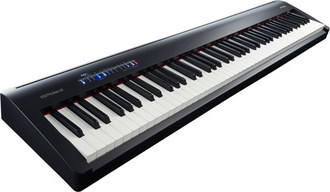 9.2 / 10
Rating
Reviews
From what I managed to touch, Roland became my choice. Excellent sound, sufficient transportability for performances, ease of playing on a split keyboard. |
|
54 900
“Nyayaya” - the inner cat-girl squeaked in me, being touched by the rather foolish name of this company. However, it cannot be said that this affected the quality of the piano. The main disadvantage of this digital piano is in the absence of a USB port: they are not deprived of even three times cheaper pianos from our review, but this model can be used as a MIDI keyboard only if there is a MIDI port on the computer (or buy USB-MIDI adapter). However, this is more likely a high-class educational tool than a professional musician's tool. The sound here is nothing to complain about, it is very “tasty” even on the built-in acoustics. The “cavalry” keyboard is comfortable and has excellent sensitivity, but it’s pretty loud - when you play at a low volume, you involuntarily start to feel the accompaniment of drums. Still, the sound quality is largely redeeming. Main advantages:
Minuses:
|
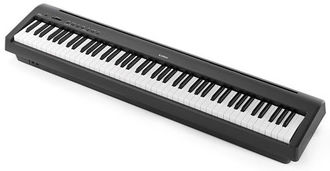 9.0 / 10
Rating
|
The best corps "modern" middle-class piano
|
65 000
Built-in acoustics with a capacity of 22 watts per channel allows you to use this tool in small rooms without additional amplification. Like many tools of this class, the “user interface” is minimalist here, the operation mode control buttons do not stand out against the general background. About the sound of the piano is difficult to say something. When some flaw is clearly felt, an object for description immediately appears, but here everything is so “licked out” that you don't even know what to cling to. If we really need to find fault with the layout, with a height taller than 180 cm, it is convenient to get behind this piano only with certain tricks. Main advantages:
Minuses:
|
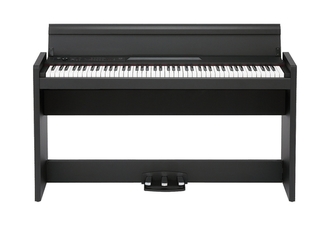 9.7 / 10
Rating
Reviews
The best digital piano, with such a price, the sound definitely surpasses most of the instruments I have heard. |
|
61 871
If you compare the piano Yamaha and Korg, it is rather instruments for different styles of play than instruments that differ significantly in themselves. If on the keyboard of “Korg” the hands are more likely to be asked to play long, heavy chords, then on the “Yamaha” I would rather like to fly on the upper register, if not the thirty second, then the sixteenth, certainly. The Yamaha loses mainly in the power of the built-in acoustics, but almost doubled. Perhaps, by the way, in many respects the difference in the character of the sound from precisely this - the bottom of the “Korg” is already noticeably spreading along the body, transmitted to the fingers, the “Yamaha” does not have that. However, 12 W "Yamaha" for home use is more than enough. Main advantages:
Minuses:
|
 9.6 / 10
Rating
Reviews
I didn’t play such pianos very often, but I still think that Yamaha, as always, had the instrument at the level. |
|
63 832
The cheapest of the popular digital pianos with the “modern” body stands out from among them primarily outwardly, and not in the best way: it looks more like a synthesizer squeezed into a chipboard body. Comparisons with the ascetic design of the Korg or Yamaha are useless here. The words about chipboard as a case material were not an exaggeration: this compact weighs, in general, the piano is slightly less than 60 kilograms. Even a 50-watt acoustics in total are not able to “stir up” this design, although the watts here are rather “Chinese”. About the synthesizer, we also said not in vain - the bank of sounds here has as many as 599 presets, but with an obvious sacrifice of quality to the quantity. In general, the Chinese went their own way - they did something lax with average sound quality, but in the characteristics they write “599 tones, 203 auto-accompaniments, 100 effects” in large letters, like tetris “999 games in 1”, where all these games were suspiciously similar. In general ... Well, if your finances are just barely enough, and you want to buy an instrument of precisely this form factor, then Medelli is for you. Main advantages:
Minuses:
|
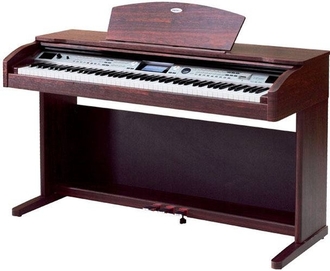 9.3 / 10
Rating
|
The best corpus "modern" high-class piano
|
89 990
Extremely concise and excellent sounding - such a definition for this digital piano is best suited. This is not surprising - each key here is equipped with three sensors, so that the instrument is capable of transmitting all the nuances of the sound technology. For sampling, a nine-foot concert grand piano by the Yamaha CFIIIS was used here. Do you want to hear the sound of the piano for 87 thousand dollars in the instrument for 87 thousand rubles? Perhaps, the difference will be found only by professionals with perfect hearing or clinical audiophiles, but who is interested in the opinion of the latter? Send them to warm up their platinum network cables and sit by the keys. Although under the keyboard lies a monstrous number of sensors and wires, it completely conveys the sensations of full-fledged "mechanics", and this applies to even minor nuances. Closing your eyes, you can very convincingly imagine the moment when a blow to the string occurs ... and it just does not have it. The minus of the minimalistic interface is that you have to use an external device to control the piano settings. Well, since the piano is digital, then an iPad on the music stand would be appropriate. Main advantages:
Minuses:
|
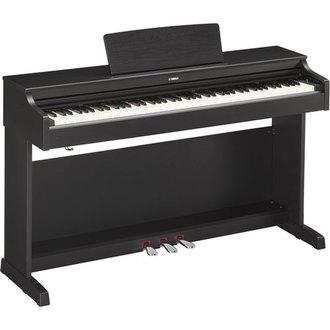 9.9 / 10
Rating
Reviews
Perhaps audiophiles will bite me, and I will also begin to feel the ultrasonic overtones, but so far for me the sound of “Yamaha” is perfect. |
|
95 989
If “Yamaha” was built exactly as a piano (but it also fulfills this task for one hundred percent), then “Roland” with its 316 timbres is rather a universal. Let's add the built-in auto accompaniment ... and realize that it’s extremely inconvenient to use all this "wealth" with such a minimal design. Well, the iPad will again replace the row of buttons and the microscopic display. Connect it via Bluetooth to the piano, run the appropriate application ... (Here the author spat and went to include a real guitar with iron strings in a live tube amplifier, cursing loudly along the way). Okay, back to the sound. The implementation of "live" instruments is very convincing here, and only a person with a delicate ear in a "blind test" can hear the difference between Roland and Yamaha. In the loser, the convenience of the keyboard is more - alas, there is no such sensitivity to the technique of the game as that of Yamaha. Main advantages:
Minuses:
|
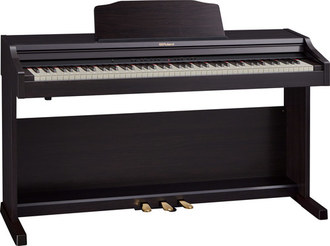 9.5 / 10
Rating
|
The best corpus digital piano high class
|
134 990
How nice that Hamster - not a musician, and the bloody battle with the Toad will not take place. Alas, tools of this class have never been cheap, and among them CLP-545 is rather one of the most affordable. If we recall that the legendary (without exaggeration) Bösendorfer Imperial was used to record the samples ... Considering how the built-in stowatt acoustics sounds, it remains only to envy those who will learn to play this piano. Yes, you heard right - there really is a learning function! Up to the full set, auto accompaniment and the ability to record up to 250 tracks with a multitrack go to it. However, there is no point in telling a lot about this piano. Enough to listen to him. Shut up and take my money! Main advantages:
Minuses:
|
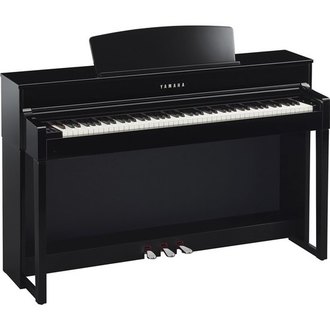 10 / 10
Rating
|
Summary: And so, which digital piano to choose?
So, what to look at first? If the instrument is bought for the home, then, naturally, on keyboard. It is unlikely that you will be able to experience all the subtleties of sound in the conditions of the new panel building, but the “flat” and devoid of feedback keyboard will definitely spoil the tactile pleasure of the game, like its technique. In the end, most of the instruments have a MIDI interface, and you can always buy a high-quality external sound card for your PC and play through the plug-in that you like.
But the concert instrument is primarily needed sound, and the plastic sound of the recompressed samples is not an assistant here. In the professional-grade instruments, the sample of each key is written even for different pressing efforts separately, but a cheap piano can “pull” an entire octave from one sample. I think it is not necessary to compare the sound quality in these cases.
Have a good shopping!
